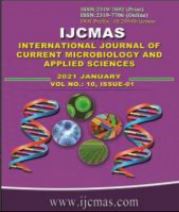


 National Academy of Agricultural Sciences (NAAS)
National Academy of Agricultural Sciences (NAAS)

|
PRINT ISSN : 2319-7692
Online ISSN : 2319-7706 Issues : 12 per year Publisher : Excellent Publishers Email : editorijcmas@gmail.com / submit@ijcmas.com Editor-in-chief: Dr.M.Prakash Index Copernicus ICV 2018: 95.39 NAAS RATING 2020: 5.38 |
Pseudomonas aeruginosa is a Gram-negative, rod-shaped and asporogenous bacterium. It has a pearlescent appearance and grape-like odour. P.aeruginosa grows well at 25°C to 37°C, and its ability to grow at 42°C helps distinguish it from many other Pseudomonas species. It has been known to cause of variety of other infections like pneumonia, urinary-tract infection, skin and soft-tissue infections, in severe burns and in infections among immunocompromised individuals. Objectives of the study is to isolate& identify Pseudomonas aeruginosa & other species (spp) from various clinical samples; to find out their distribution in various areas in the hospital; to study their antibiotic resistance pattern. It is a Lab based retrospective study conducted between the study period of April 2018- March 2019 at the Department of Microbiology ESIC Medical College, Sanath Nagar, Hyderabad. A total of 10,988 samples were received at Department of Microbiology laboratory between the study period out of which 2488 samples were found to be culture positive. Pseudomonas aeruginosa & spp was isolated in 142 samples (5.8%) out of total 2488 samples. The prevalence of Pseudomonas aeruginosa & spp. in our hospital setting was maximal in the In patient department (Wards & ICU’s).The strains isolated from out patient department were mostly found to be sensitive to most of the antibiotics. Highest resistance was noted in Pseudomonas aeruginosa & Pseudomonas spp tolevofloxacin (47.3%,45.5%), ciprofloxacin (45.7%,39.1%), ceftazidime (38.7%,30.4%). Whereas least resistance was encountered with Tobramycin, Netilimycin & piperacillin tazobactam followed by Carbapenams. Regular bacteriological identification and antimicrobial susceptibility surveillance P. aeruginosa is needed to identify the antimicrobial resistance pattern in the setting of our hospital.
 |
 |
 |
 |
 |